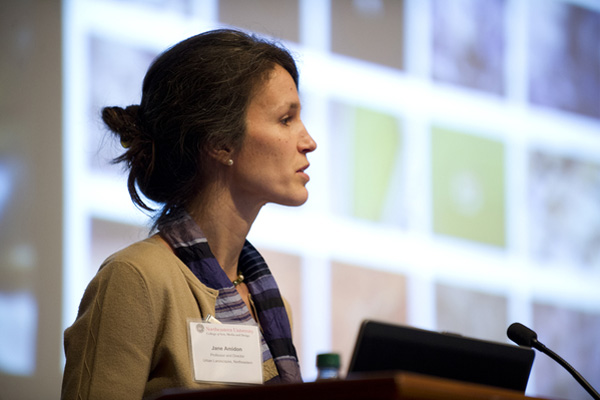The secrets to success in urban design

The key to designing successful sustainable cities of the future is keeping many factors of urban design in mind simultaneously, according to landscape architect Gerdo P. Aquino.
Aquino, president of the SWA Group, an internationally recognized landscape architecture, urban design, and planning firm based in California, served as the keynote speaker on Tuesday at Northeastern at the university’s City Design and Sustainability Symposium, held in the Curry Student Center Ballroom. He explained that building successful cities of the future depends on whether many factors at play in urban design—business, science, politics, culture, just to name a few—are flowing in unison and supplementing each other. This approach, he said, allows cities to develop multifaceted infrastructure that addresses current objectives and can adapt over time to meet the needs of an evolving populace.

Gerdo Aquino, president of SWA, a landscape architecture, planning, and urban design firm, gives the keynote address at the City Design and Sustainability Symposium.
“We’re trying to get a point where all those factors are moving at the same pace,” Aquino said. “When that occurs, great design happens and great planning happens.” He pointed to several case studies from his firm’s work around the globe, including green roof buildings in California and an urban forest project in Shanghai.
The symposium—sponsored by the College of Arts, Media and Design and the Northeastern Center for the Arts—drew interdisciplinary experts from academia and the public and private sectors for a daylong conversation focused on how to design sustainable cities for the future. Jane Amidon, professor and director of Northeastern’s urban landscape program, organized the inaugural event.
“As jobs and industries change, we see economies change and new lifestyles emerge, and we see the building blocks of the city start to evolve,” Amidon said in opening remarks. She added that design thinkers must bring their individual expertise to forums like this one to develop interdisciplinary solutions for sustainable urban landscapes.
Xavier Costa, founding dean of the College of Arts, Media and Design, noted that the event aligns with the university’s effort to trumpet sustainability initiatives across disciplines through innovative faculty research, student projects, and guest speakers. Sustainability is one of the university’s top research themes, along with health and security.
Throughout the day, panel discussions addressed many of the complex issues related to designing sustainable cities from three angles: science of design, policy of design, and business of design. All three panels were moderated by Northeastern faculty: Amidon; Brian Helmuth, professor of environmental science and public policy; and George Thrush, director of the School of Architecture. The lectures can be viewed here.
In the first panel, participants discussed the effect of science, technology, and the environment on the urban landscape. Climate change, panelists noted, presents significant challenges with regard to air quality and rising temperatures and sea levels. Nigel Jacob, who co-founded the city of Boston’s Office of New Urban Mechanics, which serves as a civic innovation incubator, discussed the intersection of civic life and city services. He noted, for example, how a mobile app, Citizens Connect, brings residents to the conversation.
Panelist Matthew Eckelman, an assistant professor of civil and environmental engineering, further noted that the pace of urbanism presents both great opportunities and problems for engineers. He recently read that by 2030, the amount of new city space being added around the world will equal roughly the size of Mongolia.
“The big push on engineering, and many other disciplines, now is understanding the systemic effects, trying to couple all of the engineering systems that need to take place in a city like this and understand how they interact with the natural systems around them,” Eckelman said.





